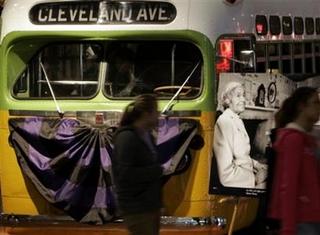Rosa Parks' Bus Draped in Black As Tribute


By TOM KRISHER
Visitors streamed into the Henry Ford museum for a glimpse of the bus that officials say was the historic one Rosa Parks rode, now draped with purple-and-black crepe to mark her death.
Parks, whose refusal to give up her bus seat to a white man in Montgomery, Ala. sparked the modern civil rights movement, died Monday at age 92.
Shortly after her death, museum officials moved the restored 1948 General Motors bus toward the center of the museum concourse. A display case later was placed next to the bus with the uniform worn by J.F. Blake, the driver who told Parks to leave her seat.
Jessie Daniels, 70, a student monitor and substitute teacher at a school on the museum campus, once lived in Montgomery, Ala. and took part in the bus boycott that followed Parks' arrest in December 1955.
"We were looking for change," he said. "Luckily for us, Rosa Parks decided to keep her seat on the bus that day."
As Americans remembered Parks' historic act of defiance, a family spokeswoman announced that public viewings would take place in both Montgomery, Ala. and Detroit before Parks' funeral.
A viewing was planned at St. Paul AME Church in Montgomery, Ala. on Saturday and Sunday, Karen Dumas, a spokeswoman for the Parks' family and charitable foundation, said Tuesday night.
A viewing also was scheduled Nov. 1 at the Charles H. Wright Museum of African American History in Detroit, Dumas said, with funeral services on Nov. 2 at Greater Grace Temple.
The Henry Ford museum purchased the rusty 36-passenger bus from a Chicago auction house in 2001 for $492,000. It had been sitting in a field for more than 30 years, said William Pretzer, the museum's curator of political history who led the acquisition.
Museum officials say it was the one Parks rode because its number corresponds with a notation that was made by a former bus station manager in his scrapbook of newspaper clippings kept during and after the bus boycott.
The bus was restored with a $300,000 federal grant to look like it did on the day Parks boarded it, Pretzer said.
Every day, museum guides invite visitors on board the bus. On Tuesday, Megan McLean, 15, sat in the same seat the civil rights pioneer had refused to yield to a white man nearly a half-century ago.
"It was overpowering," the teenager said. "I kind of felt like I was really there for a minute."
Source: Associated Press

0 Comments:
Post a Comment
<< Home